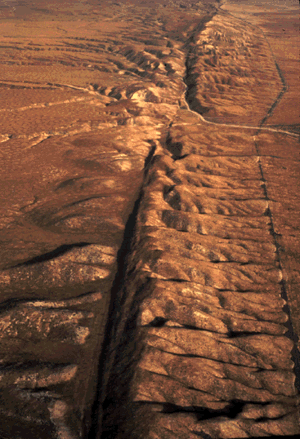12 December 2012
California’s faults have synchronized bursts of movement
Posted by kramsayer

Sections of the San Andreas fault, seen here in Central California, shake in time with a neighboring fault, according to new research. (Credit: USGS)
Twenty years after the Loma Prieta earthquake, seismologists are still learning from the faults that zigzag across California. Now, new information on the movements of two of these faults suggests they are shaking in tandem.
Some of the worst earthquakes in California have occurred along the San Andreas Fault, including the disastrous 1906 San Francisco earthquake. In 1989, the magnitude 6.9 Loma Prieta earthquake shook Northern California, with an epicenter about 70 miles south of San Francisco.
Different sections of the 810-mile San Andreas Fault move at different rates. Some stretches, like the 150 miles between Loma Prieta and Parkfield, typically creep along. The two sides move steadily past each other, the friction creating mini-quakes that are barely felt. North and south of this area, the San Andreas is considered “locked.” There, the two plates tend to stay still, building up tension until an earthquake jolts one plate north by anywhere from a few inches to several feet.
Studying part of the fault’s creeping zone, seismologists at University of California, Berkeley, have tracked its movements by monitoring small quakes. In 2004, they found that mini-quakes peak every three years in the central section.
Ryan Turner, a seismology graduate student with the Berkeley Seismological Laboratory in California, recently looked at a 12-mile slice of the fault near San Juan Bautista, just north of the previously studied section.
He studied nearly 30 years of quakes along the San Andreas and nearby Sargent Fault. Together, the San Andreas and Sargent faults in this small region had 5,000 to 6,000 seismic events since 1984. He presented his findings 5 December at the American Geophysical Union’s Fall Meeting in San Francisco.
Turner found that after the 1989 Loma Prieta earthquake, the San Juan Bautista section of the San Andreas Fault took about 10 years to settle down. Eventually, the seismicity fell into a cycle, peaking every three years. But Sargent Fault, just a few miles east, was quiet in the years after Loma Prieta and then became more seismically active. Even more surprising, its activity synched with the San Andreas’ three-year cycle.
“That pulsing [from San Andreas] continues in the north and drives movement on both of these faults,” Turner said. He suggested that activity deep under the surface could be responsible for the paired movement of these faults.
Turner’s findings provide insights into how neighboring faults respond to big earthquakes. The information, he said, could be folded into more accurate earthquake prediction models for California.
-Rina Shaikh-Lesko is a science communication graduate student at UC Santa Cruz


 GeoSpace is a blog on Earth and space science, managed by AGU’s Public Information staff. The blog features posts by AGU writers and guest contributors on all sorts of relevant science topics, but with a focus on new research and geo and space sciences-related stories that are currently in the news.
GeoSpace is a blog on Earth and space science, managed by AGU’s Public Information staff. The blog features posts by AGU writers and guest contributors on all sorts of relevant science topics, but with a focus on new research and geo and space sciences-related stories that are currently in the news.